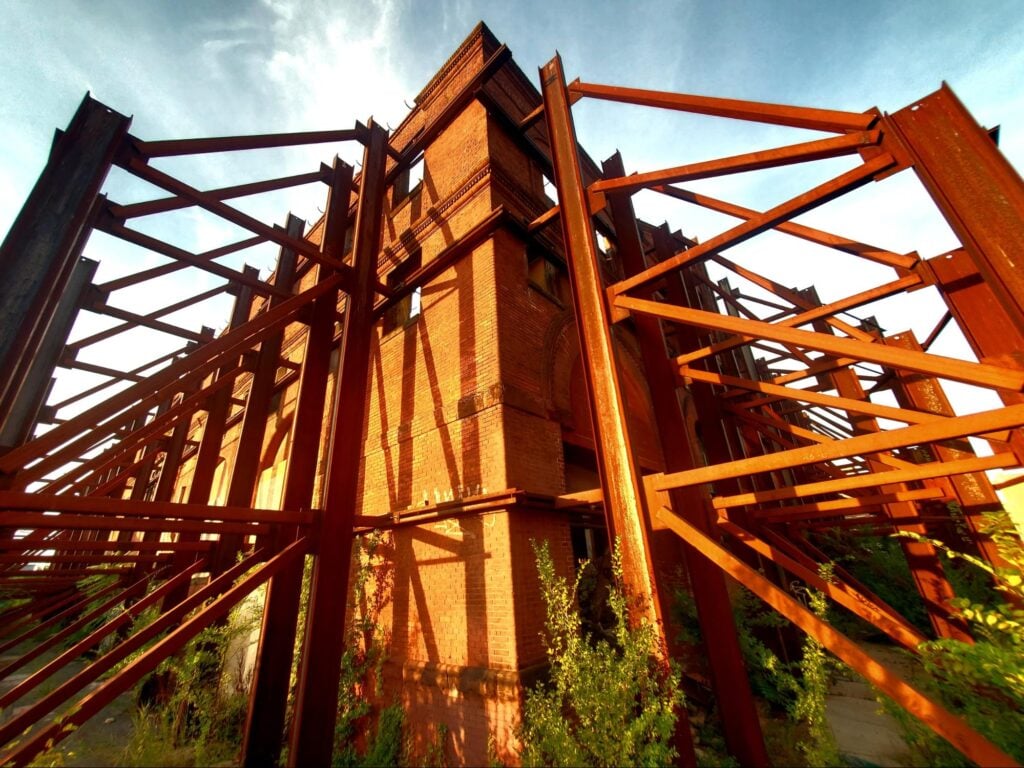Understanding Structural Rigidity in Historic Brick Walls: Signs, Causes, and Preservation Tips
Why do historic brick walls crack, bow, or fail over time? One major factor is structural rigidity—how well the wall resists internal and external forces. In this article, we examine what makes historic brick walls stable, why they sometimes fail, and how to preserve them. You’ll learn about corbelled footings, causes of lateral deflection in masonry, and how proper techniques in Washington DC historic masonry preservation can help extend the life of your structure.
In this article, part of a two-part series, we are starting a discussion and taking a closer look at the concept of structural rigidity in a historic brick wall, details or touching on the following subtopics:
- Individual small units: built to create a cohesive bond.
- Corbelled footings: before the widespread use of concrete.
- Lateral deflection resistance: common structural failure points
- Slow insidious damage from biocolonization.
- How deterioration and destruction can be mitigated by repointing and historic masonry preservation.
- Once historic architecture is lost, it’s lost forever and why preservation and conservation is valuable.
What Causes Historic Brick Wall Cracks?
Cracking in historic brickwork often stems from issues related to structural rigidity, moisture intrusion, and external lateral forces. When a wall loses its structural cohesion—due to failing mortar, differential settlement, or lack of proper coping—cracks begin to form. In our DC neighborhoods like Capitol Hill or Dupont Circle, these failures are common and often tied to neglected maintenance.
Individual small units built into a cohesive web
The construction of individual small brick units to create a cohesive bond in a larger assembly is a fundamental aspect of brick masonry, crucial for the structural integrity and stability of walls and buildings. These building assemblies work together by structurally interlocking a multitude of small units together, but the overall strength axis lies in that interlock.
In brick masonry, each brick is a small, rectangular building block, each individually strong in compressive force resistance, but without any lateral capacity. These individual bricks are placed and aligned to interlock with one another. The key to their structural strength lies in the way they bond together. Bricks are not simply stacked on top of each other; they are staggered horizontally and vertically, creating a pattern that helps distribute loads evenly. In some ways the bond is like a woven tapestry where the contextual positioning of bricks within the bonds ties bricks together across separate wythes.
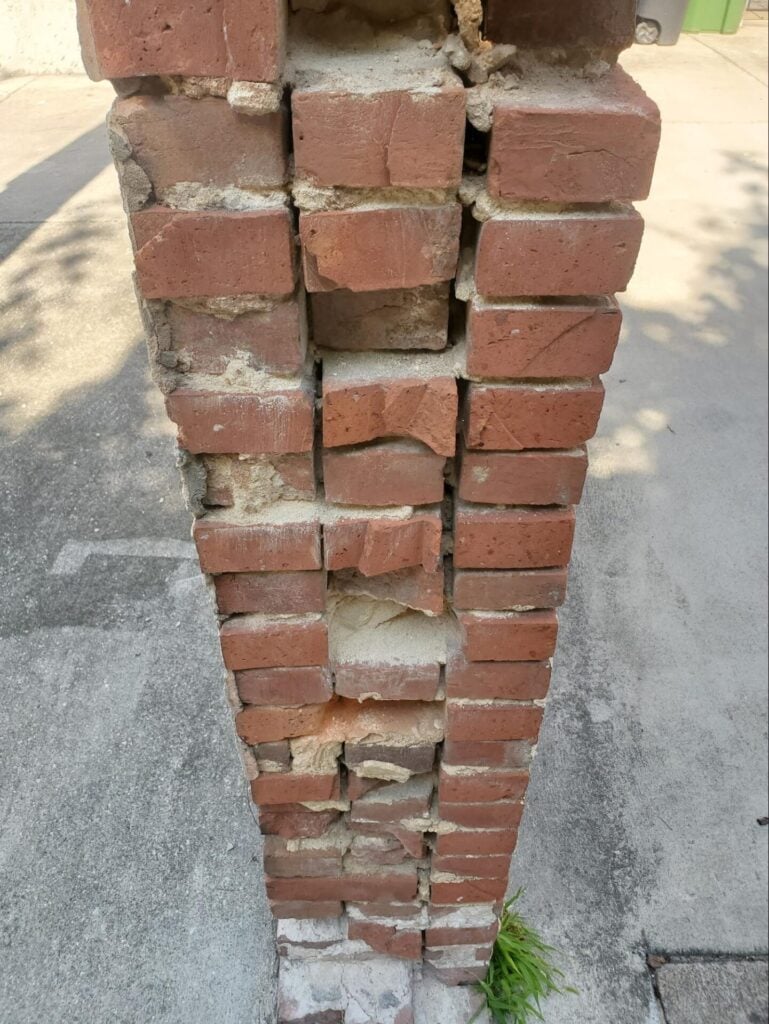
The term “wythe” in the context of masonry refers to a single vertical layer of bricks or stones in a wall. It’s essentially a continuous vertical section of a wall that’s one brick or stone thick. The term is often used in construction and architecture to specify different layers or sections within a wall.
The word “wythe” itself has an interesting etymology. It comes from the Middle English word “wythe” or “withe,” which means a willow tree or willow branch. In Old English, it was “wīþ,” and in Middle High German, it was “wīde.” The connection between willow branches and wall construction likely lies in the historical use of woven willow branches or wattle as an early form of construction material for walls and fences.
Over time, the term “wythe” evolved to describe the individual layers of bricks or stones in a wall, helping builders and engineers specify and communicate the structure of masonry walls more precisely.
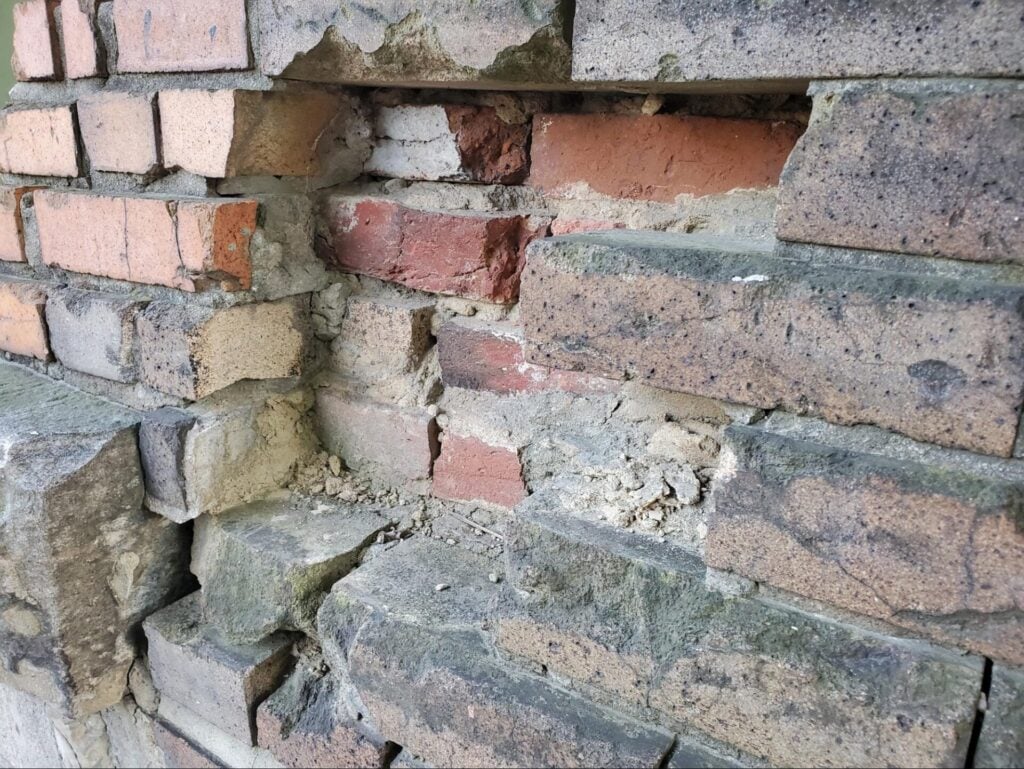
The gaps or spaces between bricks are filled with mortar, a mixture of binder (generally made from lime and or portland cement), sand, and water. Mortar serves two essential purposes. First, it provides adhesion, acting as a glue that bonds the bricks together. Second, it helps to evenly distribute loads and stresses across the entire wall by filling in the gaps and providing lateral support. The majority of historic bricks used in Washington DC neighborhoods such as Capitol Hill, Georgetown and Dupont Circle or call common bricks. These bricks were mostly used at the rear facade and the side demising walls and footing and foundations of the building. A different type of brick called a pressed brick was used at the exposed portion of many, but not all, front facades. We specifically use the word “exposed” portion, to describe the area where pressed bricks were most commonly used because even in pressed brick walls of double or triple wythe thickness, the internal wall wythes were generally built with common brick. Common brick was much cheaper but had significantly lower consistent in size, shape, straightness, etc. This inconsistency makes the mortar’s job of filling even more important, because that mortar is required to be the buffer, a flexible intermediary, absorbing the physical and spatial variations and discrepancies.
Bricklayers have used a variety of bond patterns, for centuries, to achieve structural stability. The most common bond pattern is the “running bond,” where bricks in one course (horizontal row) overlap the bricks in the course below. This overlap ensures that no vertical joints are continuous, directly aligned between separate wythes or courses, throughout the wall, which would weaken the structure. This pattern is also referred to as a “stretcher bond,” where all bricks are oriented with their long sides facing out. This creates a visually appealing, uniform appearance while still maintaining structural stability, but not as string between wythes as other bond patterns.
Header Bricks: In addition to the regular bricks (stretchers) that run lengthwise along the wall, header bricks are used in different brick bond configurations. These are placed perpendicular to the wall’s face, typically every few courses. Header bricks contribute to the wall’s strength by tying the two faces (outer and inner) together and preventing them from separating.
The cohesive strength between individual bricks is the key to the rigidity of a wall and building and is based both on the bond, and the interaction between the bricks, mortar, and bond pattern creates a cohesive and stable structure. The staggered arrangement of bricks and the bonding provided by arrangement and mortar allow the wall to resist lateral forces (pressure from the sides) effectively. In contract, compressive loads (pushing together) are somewhat not necessarily reliant on bond and mortar, theoretically. Essentially, the Bricks themselves inherently have a compressive strength resistance, but in practice, those bricks are all part of the overall assembly and that motor either becomes a supporting element or a weak link, and when built correctly the mortar and bond become a supportive element.
The individual bricks, when properly arranged and bonded, distribute the forces acting on the wall throughout the entire structure. This prevents the wall from collapsing under its weight or external pressures. The bricks work together as a unified system, with each one playing a critical role in maintaining the wall’s shape and integrity.
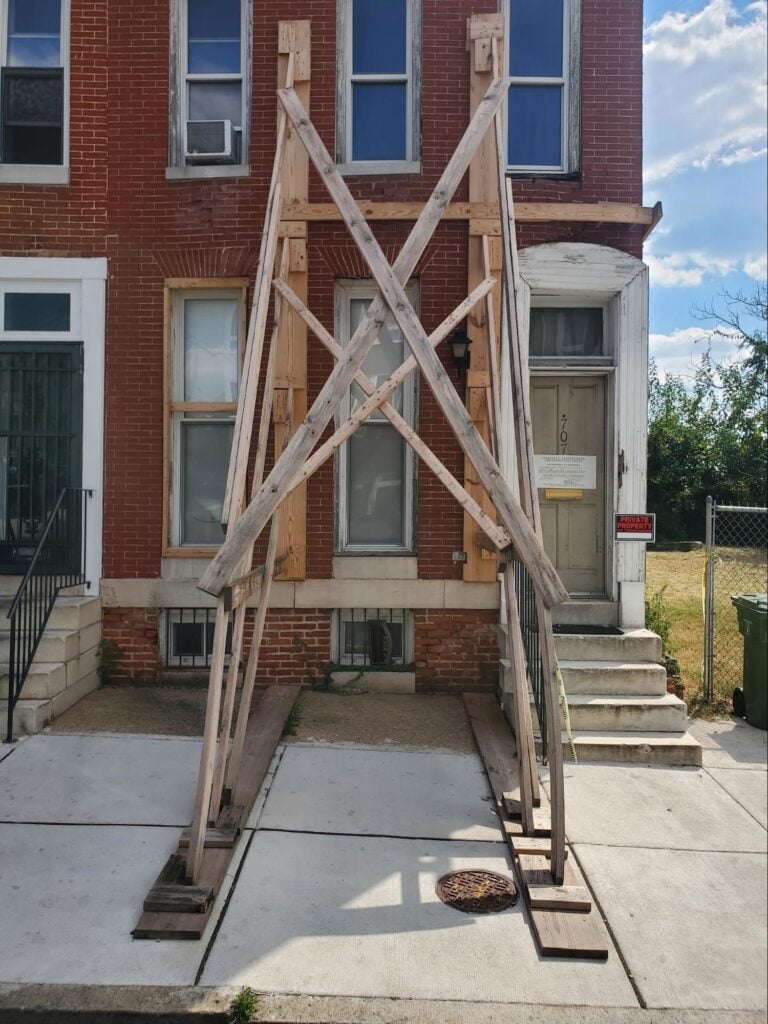

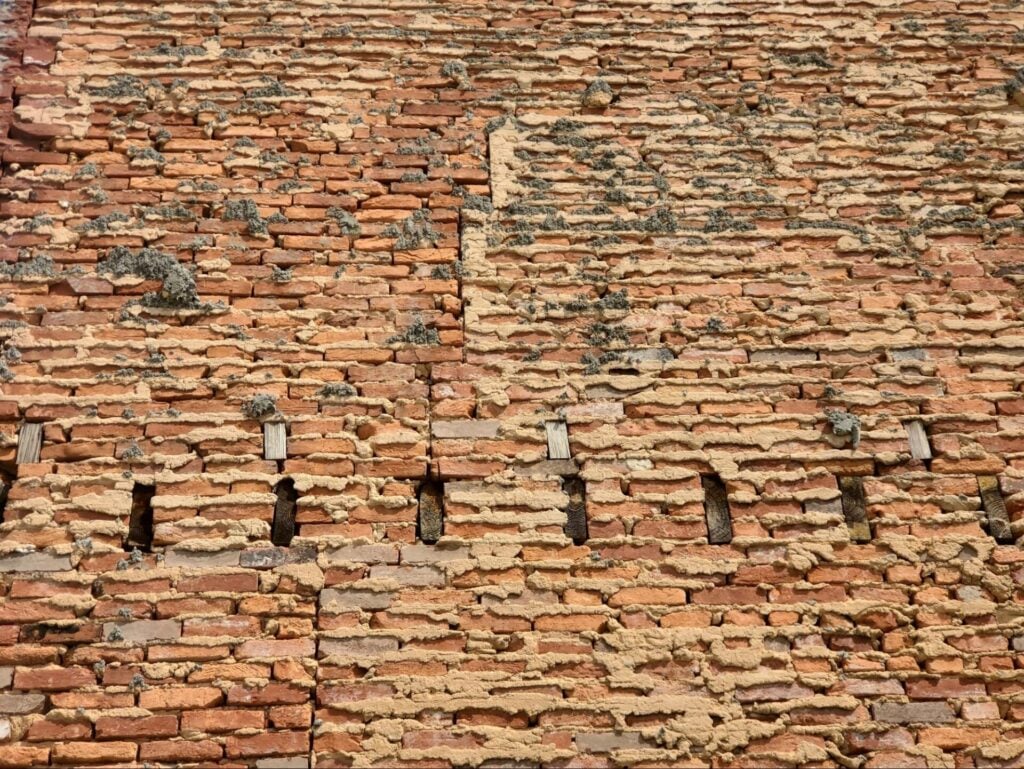
In summary, individual small brick units are strategically arranged, interlocked, and bonded with mortar to create a cohesive and stable structure. The way bricks are stacked, combined with the use of various bond patterns and header bricks, ensures that the wall can resist collapse and maintain its shape and form, even while carrying a heavy load for decades, contributing to the overall strength and durability of historic buildings constructed with brick masonry.
If you’ve noticed cracks, leaning walls, or signs of movement in your historic brick building, we can help. Our team specializes in historic masonry preservation and repairs across Washington DC. Call (202) 800-1751 or contact us here.
Historic Corbelled Footings and Their Role in Preserving Historic Masonry
Corbelled footings in historic brick structures, predating modern concrete use, played a vital role in preserving historic masonry. Found in DC rowhomes, these stepped foundations helped distribute load while minimizing settlement. Corbelling is a construction method where successive courses of bricks or stones project slightly beyond the course immediately below or above them. We often see corbelling at the top of facades of historic rowhomes without applied cornices or mansard roofs. In the context of historic brick structures, corbelled footings involved the use of bricks arranged in a stepped or cantilevered manner to form the foundation of a building which spreads out further getting wider as it goes further down.
Corbelled footings served the purpose of gradually expanding the footprint at the base, corbelling distributed the vertical loads of the structure over a larger area, reducing the risk of settling or foundation failure. This technique provided compressive load stability to the walls, helping to counteract or resist some of the external forces, ground movements, and effectively reduce the risk of differential settlement.
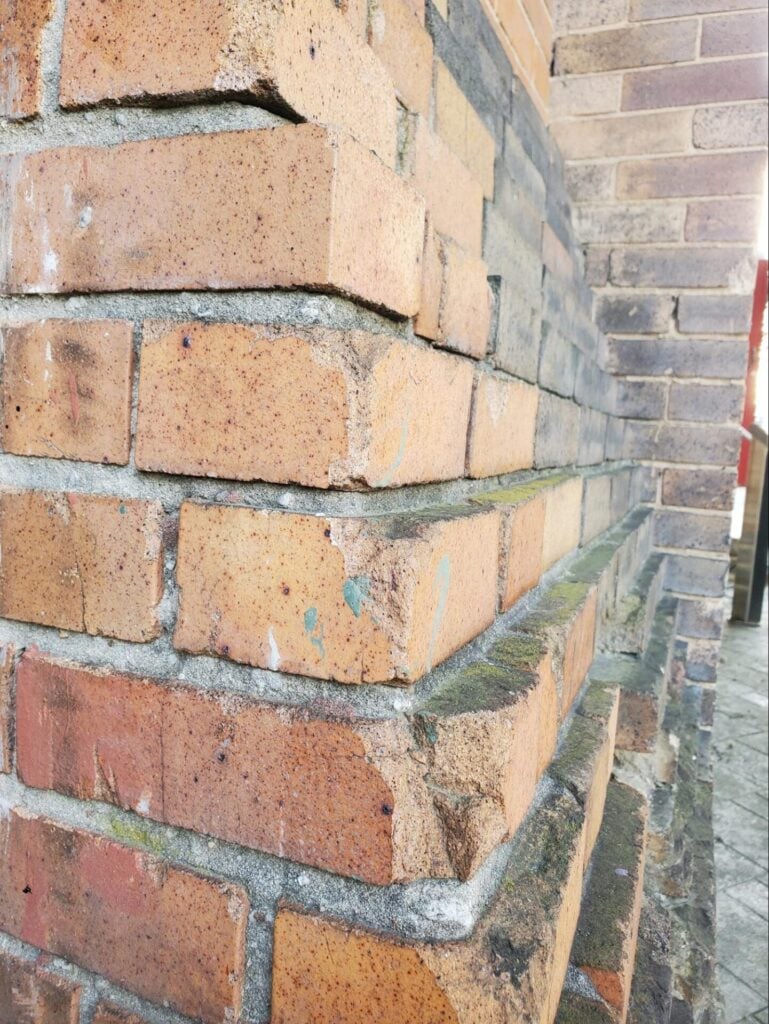
A contemporary spread footing, a variant of a basic footing, particularly common in cast-in-place concrete footings, creates additional bearing distribution by dispersing the load of a building or structure across a broader expanse of subsoil. A spread footing features a broader base compared to a standard footing. This wider base is purposefully designed to better distribute the weight and loads imposed by the superstructure.
In modern construction practices, the application of spread footings is useful to improve structural stability of a building’s mass. The increased width of the footing lessens the risk of uneven settlement or structural tilting, especially when subjected to varying loads or variations in soil characteristics. By extending the load-bearing area and reducing the pressure on the underlying soil, spread footings can improve the overall bearing capacity at a lower proportional expense to commensurate additional footings or additional engineered soils.
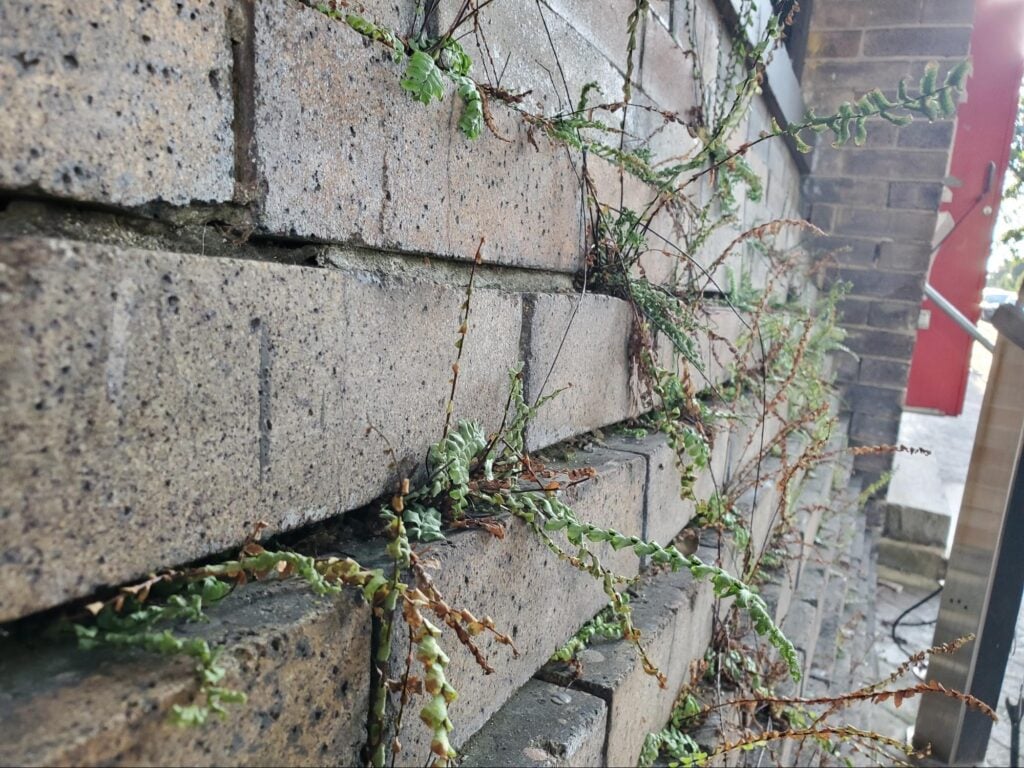
Historic corbelled footings were typically constructed using the same materials as the rest of the building, such as common bricks, often locally sourced, and almost never the roman brick nor pressed brick found at exposed building facades. The quality of the materials and workmanship wasn’t really considered in the strength or durability of these footings. Essentially, these footings and successive foundations were considered superior to compacted earth and therein considered sufficient. Often damp-proof courses made from slate tile between a selected brick courses a few inches above the earth grade acted like a wicking barrier. Compared to brick, slate stone is considered to be largely impermeable to water and a course of slate tile installed at the top of the foundation will essentially prevent the permeation of water upwards into the upper walls of the building. Even though over a 100 years ago, the modern liquid or roll applied type waterproof and elements that we use today we’re not available or even invented yet at that time, people still understood that moisture could cause significant damage, both to connected framing and other parts of the structural walls and elements of the building above grade. This slate tile worked similarly to how a modern dampproof course would work today.
While corbelled footings were an effective method in their time, they had limitations. Over time, they could suffer from deterioration due to moisture infiltration and the lack of waterproofing techniques that modern concrete footings provide. Additionally, they required additional excavation and work in a confined space, making them labor-intensive, especially in masonry applications. With the advent of concrete as a construction material in the late 19th and early 20th centuries, builders transitioned to using concrete footings. Concrete offered improved strength, durability, and resistance to moisture-related issues. This marked the decline of corbelled footings in favor of more modern foundation systems.
Lateral Deflection and Bowing Brick Wall Repair
One of the most serious signs of failure in a masonry wall is bowing—a bulge or curve caused by internal pressure or external lateral force. These issues often require bowing brick wall repair, especially in historic homes where preserving the original material is key. Understanding the causes of lateral deflection in masonry—such as weakened mortar, plant growth, and repeated external vibration—can prevent major structural damage.
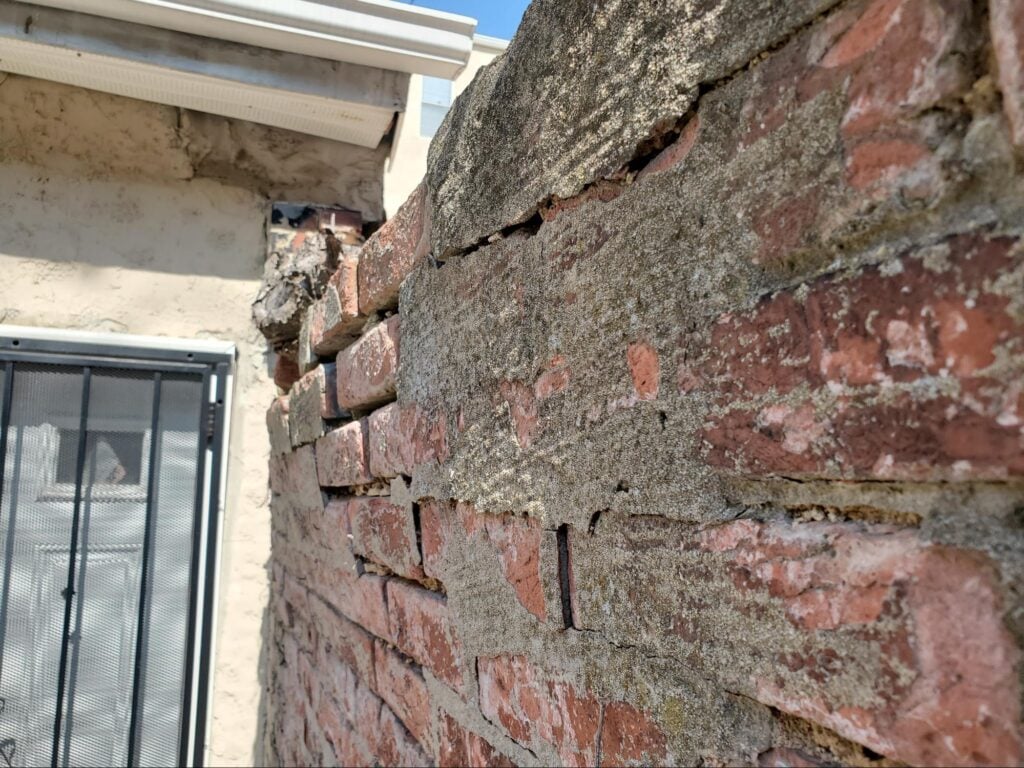
In some cases earthquake washers are used to provide lateral deflection resistance at untierupted flat walls with bays built into the footprint of a facade. Corners, simply by the nature of the turn in the direction of a wall, consume additional materials and significantly more labor in the construction process, yet provide significant resistance to lateral deflection. Essentially, at a corner in a tall vertical wall, resistance and strength are exponentially bolstered, as the corner creates a combined stabilization force. Often through, internal floor plans, and limited site development space simply don’t allow for economical use of facade projections or recesses. Uninterrupted straight walls, without bays or projections are commonly found at side walls at the ends of building rows.
Often slow deterioration of the cohesive strength of the mortar in brick and mortar historic walls can lead to weakening of a wall structure. Once weakened through mortar deterioration, the problems of a compromised strength axis can be exacerbated by biocolonization and plant growth, differential settlement, and outside factors of force such as trash trucks in an alley or renovations in neighboring rowhomes. Mortar plays a crucial role in, not just leveling, but also holding the bricks together in a masonry wall. Over time, the mortar can deteriorate due to various factors, including weathering, moisture, and freeze-thaw cycles. As the mortar deteriorates, its cohesive strength diminishes, leading to a weakening of the overall structure.


As mortar deteriorates, the deterioration often create gaps and voids within the wall. Biocolonization, which includes the growth of algae, lichens, and fungi, and can eventually leaf to growth of actual plant life can exacerbate the problem. These microorganisms can further deteriorate the mortar and contribute to surface erosion. As these very small forms of biological growth propagate on the surface of deteriorated mortar, they increase the rate of further deterioration. Fungi, often seen growing on deteriorated organic services like fallen trees in the woods, doesn’t actually have roots, but they have a different type of root like structure called mycelium. Tree roots are known to cause significant damage to building materials, we have shown, on our website, several examples where tree roots have literally buckled and lifted up concrete and or heavy masonry sidewalks or patios. Mycelium is actually very strong, but it doesn’t lift massive structures like tree roots because of a different cellular structure, however In engineering circles, mycelium is actually being analyzed and tested for research and development related to the use of this biological material in actual building materials. Plant growth, such as tree roots, can exploit these voids and crevices, exerting lateral pressure on the bricks and weakening the wall’s structural integrity.
One if those articles follows at the link below:
Tree Trunks and Roots Moving Brick Columns
Historic brick masonry buildings, especially rowhomes, may experience ground settlement differentials over time. This means that one section of the building settles more than another. As a result, the entire wall or specific sections of it may tilt or bow laterally. This lateral movement can lead to structural issues, including cracks and displacement of bricks. Differential Settlement, in this case can lead to or cause lateral deflection, but at the core of the issues each condition is a unique circumstance or problem and each of these problems can occur independently.
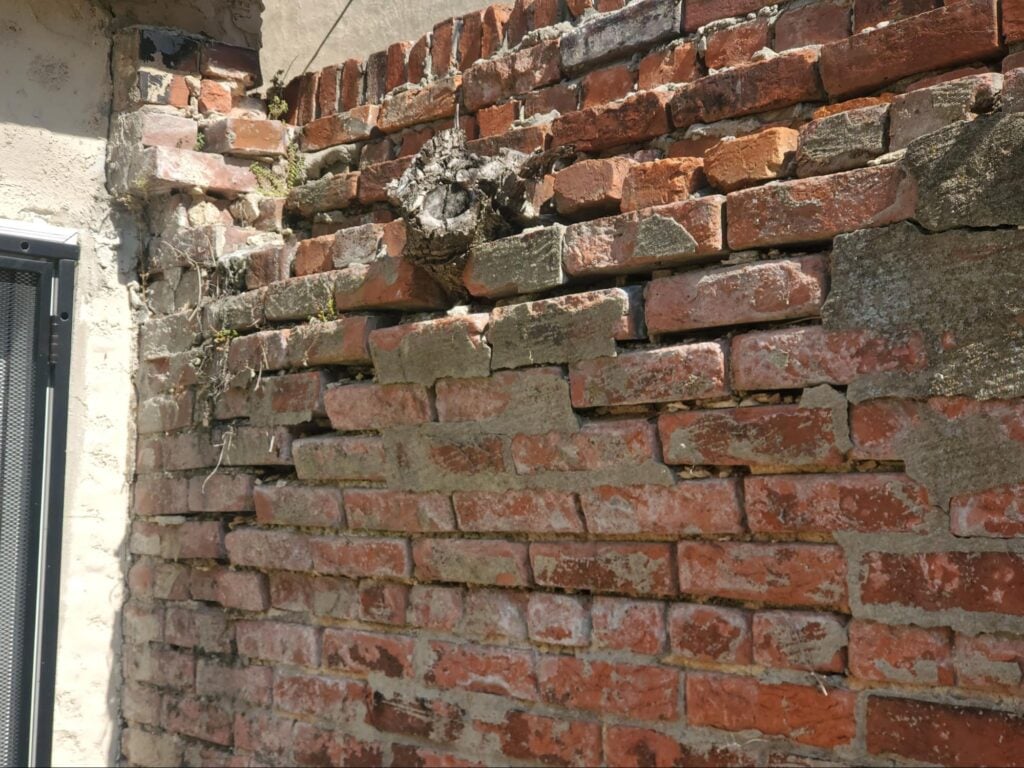
External forces from factors like heavy traffic, construction activities in neighboring buildings, or the passage of large vehicles (e.g., trash trucks in tiny alleyways rubbing against historic brick walls on a weekly or bi-weekly basis) in adjacent alleys can impart lateral forces on the walls. These forces can strain the already weakened mortar and gouge away brick facings, leading to accelerated water entry) and exacerbate lateral deflection.
To prevent or address lateral deflection failures in historic brick masonry walls, several measures can be taken. To start, brick walls need impermeable copings at the tops of the walls. For example, add a rooftop where brick walls run above the horizontal or low slope surface of the roof, copings must be installed at the top of the brick walls. This requirement applies to retaining walls and screen walls as well. All freestanding masonry walls need copings to keep water from entering the top of the brick walls, especially where the wall have horizontal tops. Commonly, in Washington DC and DC neighborhoods such as Capitol Hill, Dupont Circle, and Georgetown where there are many historical brick rowhomes, the brick rowhomes are often built with the brick wall running above the flat roof surface. In many cases local quality roof contractors will take a shortcut and wrap the top of the brick wall with a modified bitumen or single-ply type membranes. It’s better to run the membrane over the top of the parapet or brick wall than to stop the roof membrane short of the brick wall. However, still, that does not meet the code requirements. Really the best method to cap the tops of brick walls is to install a metal or similar material coping. Without a coping at the top of the wall, the wall top is a horizontal or near horizontal surface that allows water to sit and then slowly infiltrate into the double or multiple wythe brick wall. Those connected layers of bricks can separate or delaminate with exposure to the elements, as mortar and the assembly of masonry materials break down from unmitigated exposure to moisture.
Timely repointing with appropriate, historically compatible mortar can address mortar deterioration, filling voids, and strengthening the wall’s cohesion. Regular structural assessments can identify signs of lateral deflection and guide necessary repairs.
In conclusion, ensuring proper foundation support and addressing settlement differentials can help maintain wall stability. Historic brick wall cracks, bowing, or displacement all result from a combination of factors—primarily mortar deterioration, biocolonization, and external impact. If you’re concerned about the condition of your building, our team specializes in Washington DC historic masonry preservation, helping protect and restore these valuable structures with expert care.
Frequently Asked Questions About Historic Brick Wall Rigidity
1. What causes historic brick walls to crack?
Cracks in historic brick walls often result from mortar deterioration, foundation settlement, and loss of structural rigidity. External forces like traffic vibrations, nearby construction, or water infiltration can also contribute to cracking over time.
2. How do I know if my historic brick wall is bowing?
Look for bulging areas in the wall, separation at corners, or vertical cracks. A bowing brick wall may lean outward or have a noticeable “belly,” which indicates lateral deflection and possible structural compromise.
3. Can repointing help restore structural rigidity in a historic wall?
Yes, timely repointing with historically compatible mortar strengthens the bond between bricks, fills gaps, and restores structural cohesion—especially in walls that have weakened over time.
4. What are common causes of lateral deflection in masonry?
Common causes include deteriorated mortar joints, differential settlement, biocolonization, plant root pressure, and vibration from nearby traffic. These forces can push the wall out of alignment and compromise its stability.
5. Are corbelled footings still used in modern construction?
Not typically. Corbelled footings were common before concrete became standard. Today, spread footings or other engineered foundation systems are preferred for better moisture resistance and load distribution.
6. How can I preserve a historic brick wall in Washington DC?
Preserving historic masonry involves regular inspections, proper repointing, moisture control, and structural assessments. Work with a qualified contractor who understands Washington DC historic masonry preservation standards to ensure long-term integrity.
7. What role does mortar play in structural rigidity?
Mortar acts as both an adhesive and a stress buffer. It allows for the even distribution of loads, fills size inconsistencies in bricks, and helps the wall resist both vertical and lateral forces when properly maintained.
Worried about cracks or leaning in your historic brick wall? Contact Infinity Design Solutions at (202) 800-1751 or fill out our form for expert historic masonry repair in Washington DC.

